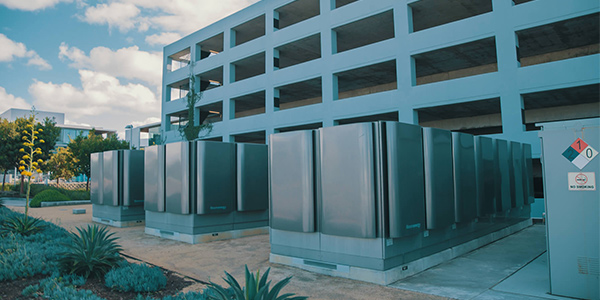FERC ruled unanimously Thursday that all fuel cells that use waste heat in an integrated fuel reforming process qualify as cogeneration facilities under the Public Utility Regulatory Policies Act of 1978 (RM21-2, RM20-20).
The commission’s rulemaking, initiated in an October order, was prompted by a petition from fuel cell manufacturer Bloom Energy, which had sought approval for its solid oxide fuel cell (SOFCs) technology. (See FERC Proposes Updating PURPA Regs for Fuel Cells.)
In Thursday’s final order, however, the commission said its new rule would also apply to carbonate fuel cells manufactured by Bloom Energy competitor FuelCell Energy in addition to SOFCs.
Fuel cells convert the chemical energy in hydrogen directly to electrical energy without combustion. SOFCs use a solid oxide ceramic material as their electrolyte — a substance that produces an electrically conducting solution — unlike fuel cells that use platinum or other precious metals. The electrolyte oxidizes hydrogen, converting it to water vapor (H2O) while producing electricity.
FuelCell Energy said its fuel cells use waste heat to produce hydrogen in a manner similar to Bloom’s.
The commission agreed with FuelCell Energy’s argument that its original proposal was improper because it endorsed a specific technology rather than establishing standards that would apply to all similar fuel cells. “The commission has not endorsed specific types of solar panels, for example, in defining small power production facilities. Here, as FuelCell Energy recognizes, the focus should be on the integrated use of waste heat for reforming hydrocarbons to produce hydrogen to fuel a fuel cell, instead of the specific fuel cell technology utilized to accomplish that goal.”
The commission rejected arguments by the Edison Electric Institute, which said Bloom’s request constituted an expansion of the statutory definition of a cogeneration facility.
The Federal Power Act defined a cogeneration facility as a facility that produces electric energy and steam or forms of useful energy, such as heat, which are used for industrial, commercial, heating or cooling purpose.
“Because … a fuel cell system with an integrated hydrocarbon reformation process creates useful thermal energy in that it is used for an industrial purpose — here, producing a commercially valuable fuel, hydrogen — it fits within” the legal definition of cogeneration, the commission said.
FERC cited Bloom’s filing of a declaration from former FERC Commissioners Vicky A. Bailey, Norman Bay, Nora Mead Brownell, Suedeen Kelly and William Massey, who said they supported the rulemaking as “consistent with the statutory text of PURPA and the definition of ‘cogeneration facility’” in the FPA.
EEI contended that FERC’s Order 70, which implemented PURPA in 1980, said facilities eligible for qualifying-facility status did not include natural gas-fired combined cycle combustion plants, even though the sequential use of heat is used to produce more electricity. EEI said the fact that combined cycle plants produce electricity from natural gas through a chemical reaction instead of combustion was not a meaningful distinction.
The commission disagreed. “Combined cycle electric generation, while admittedly a more efficient form of electric generation than, for example, a combustion turbine, is still not the same thing as a fuel cell system with an integrated steam hydrocarbon reformation process and does not warrant being identified as a qualifying facility,” it said.
Commissioner Richard Glick joined with Chair James Danly and Commissioner Neil Chatterjee in the 3-0 vote. New Commissioner Allison Clements did not participate in the vote.
“Even though these fuel cell systems will be deemed to be qualifying facilities, the order makes clear that they still must pass the fundamental use test before utilities will be required to purchase the output from these projects,” Glick said during the open meeting.
The fundamental use test narrowed the facilities that can invoke a utility’s must-purchase obligation to include only cogeneration facilities for which at least 50% of their “electrical, thermal, chemical and mechanical output” is used for industrial, commercial or institutional purposes, and not intended fundamentally for sale to an electric utility.




